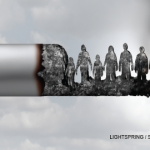In fact, Don Draper would be proud. By implanting the concept of throat protection in the minds of doctors and the general population, profits from sales of Philip Morris cigarettes soared, tripling within the first year of the ad campaign.2
Not to be undone, the makers of Camel cigarettes probably did more than other companies to link their product with widespread physician acceptance. Their ads promoted the concept that when it came to smoking, “experience is the best teacher.” Using a series of print ads, Camel highlighted how personal clinical experiences often helped famous doctors gain insight into critical issues. Couldn’t this concept be applied when choosing a brand of cigarettes? For example, one ad depicted how the famous German physician and scientist, Paul Ehrlich, MD, reached some important conclusions in microbiology that “helped create the science of chemotherapy, which is increasingly important today.”4 (A prescient observation for a tobacco company!) The ad went on to assert that, “experience is the best teacher in cigarettes, too,” implying that wise doctors and their patients should flock to Camel cigarettes, too.
The nascent television networks were swamped with idyllic commercials depicting the hectic lives of doctors and how puffing on Camel cigarettes provided them with well-deserved downtime.5 White men (and yes, they were only white men) in white coats, some clutching stethoscopes, others with otoscopic mirrors strapped to their foreheads, were always reaching for a Camel. These are hilarious commercials to watch and nowadays would fit perfectly as sketches on Saturday Night Live, although at the time of their release, they served more sinister roles.
A Perfect Match: Stress & Cigarettes
Stress was becoming a growing concern in modern societies. Its critical role in health and illness was only starting to be understood. Two San Francisco cardiologists, Meyer Friedman, MD, and Ray Rosenman, MD, first proposed the idea of a stressful Type A personality, one that was prone to heart attacks and premature death. This notion of a stress-sensitive form of personality captured the American imagination, as well as the minds of the Big Tobacco executives. They realized a windfall opportunity by linking smoking with specific personality types. All they needed was some sympathetic scientific support, and they found it, from a most credible source, Hans Selye, MD, the father of stress. If tobacco executives were seeking to engage the services of a prominent physician-scientist, there was no better person to promote the link between stress reduction and smoking than Dr. Selye.



